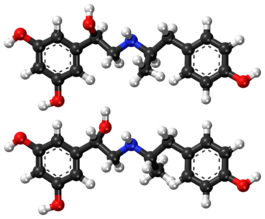Fenoterol
 | |
 | |
| Clinical data | |
|---|---|
| AHFS/Drugs.com | Micromedex Detailed Consumer Information |
| Pregnancy category |
|
| Routes of administration | Inhalation (MDI) |
| ATC code | |
| Legal status | |
| Legal status |
|
| Pharmacokinetic data | |
| Elimination half-life | 6.5 hours approximately [1][2][3][4] |
| Identifiers | |
| |
JSmol) | |
| |
| |
| (verify) | |
Fenoterol is a
Fenoterol is produced and sold by
It was patented in 1962 and came into medical use in 1971[5] but, in the 1980s, concerns emerged about its safety and its use being associated with an increased risk of death (see below).
Adverse effects and toxicity

Fenoterol is a short-acting β2 agonist that also stimulates β1 receptors. Fenoterol has more cardiovascular toxicity than isoprenaline or salbutamol.[6][7] Fenoterol was widely used in New Zealand in the late 1970s and the 1980s until it was removed from the New Zealand drug tariff in 1989 because its introduction and widespread use was associated with an epidemic of asthma deaths.[8] A series of case-control studies demonstrated that asthmatics using fenoterol were more likely to die of asthma compared with controls treated with alternative beta agonists; this risk of asthma deaths was particularly high in severe asthmatics.[9][10] The mortality rate declined following withdrawal of fenoterol[11] without evidence supporting an alternative explanation for the abrupt rise and fall in asthma deaths.[12] Data did not support confounding by severity as the explanation for the excess mortality.[13] There are alternative short-acting beta agonists that have not been associated with increased mortality e.g. salbutamol.
Stereoisomers
5-(1-Hydroxy-2-{[2-(4-hydroxyphenyl)-1-methylethyl]amino}ethyl)benzene-1,3-diol is a molecule with two different stereogenic centers. Thus, four

References
- ^ "Fenoterol Hydrobromide Drug Information, Professional". Drugs.com. 1996-01-01. Archived from the original on 2019-08-25. Retrieved 2018-06-11.
- ^ "Fenoterol - Drug Monograph". DrugInfoSys.com. 2016-10-27. Retrieved 2018-06-11.
- ^ "Berotec Inhalation Solution (Fenoterol HBr)". RxMed.com. Retrieved 2018-06-11.
- S2CID 189746.
- ISBN 9783527607495.
- PMID 2928998.
- PMID 1671326.
- PMID 7613161.
- S2CID 22765551.
- PMID 2330548.
- PMID 7613161.
- S2CID 13287788.
- S2CID 24043007.
- S2CID 42668199.
